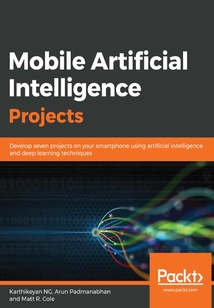舉報(bào) 

會(huì)員
Mobile Artificial Intelligence Projects
We’rewitnessingarevolutioninArtificialIntelligence,thankstobreakthroughsindeeplearning.MobileArtificialIntelligenceProjectsempowersyoutotakepartinthisrevolutionbyapplyingArtificialIntelligence(AI)techniquestodesignapplicationsfornaturallanguageprocessing(NLP),robotics,andcomputervision.ThisbookteachesyoutoharnessthepowerofAIinmobileapplicationsalongwithlearningthecorefunctionsofNLP,neuralnetworks,deeplearning,andmobilevision.Itfeaturesarangeofprojects,coveringtaskssuchasreal-estatepriceprediction,recognizinghand-writtendigits,predictingcardamage,andsentimentanalysis.YouwilllearntoutilizeNLPandmachinelearningalgorithmstomakeapplicationsmorepredictive,proactive,andcapableofmakingautonomousdecisionswithlesshumaninput.Intheconcludingchapters,youwillworkwithpopularlibraries,suchasTensorFlowLite,CoreML,andPyTorchacrossAndroidandiOSplatforms.Bytheendofthisbook,youwillhavedevelopedexcitingandmoreintuitivemobileapplicationsthatdeliveracustomizedandmorepersonalizedexperiencetousers.
目錄(190章)
倒序
- coverpage
- Title Page
- Copyright and Credits
- Mobile Artificial Intelligence Projects
- Dedication
- About Packt
- Why subscribe?
- Packt.com
- Contributors
- About the authors
- About the reviewers
- Packt is searching for authors like you
- Preface
- Who this book is for
- What this book covers
- To get the most out of this book
- Download the example code files
- Download the color images
- Conventions used
- Get in touch
- Reviews
- Artificial Intelligence Concepts and Fundamentals
- AI versus machine learning versus deep learning
- Evolution of AI
- The mechanics behind ANNs
- Biological neurons
- Working of artificial neurons
- Scenario 1
- Scenario 2
- Scenario 3
- ANNs
- Activation functions
- Sigmoid function
- Tanh function
- ReLU function
- Cost functions
- Mean squared error
- Cross entropy
- Gradient descent
- Backpropagation – a method for neural networks to learn
- Softmax
- TensorFlow Playground
- Summary
- Further reading
- Creating a Real-Estate Price Prediction Mobile App
- Setting up the artificial intelligence environment
- Downloading and installing Anaconda
- Advantages of Anaconda
- Creating an Anaconda environment
- Installing dependencies
- Building an ANN model for prediction using Keras and TensorFlow
- Serving the model as an API
- Building a simple API to add two numbers
- Building an API to predict the real estate price using the saved model
- Creating an Android app to predict house prices
- Downloading and installing Android Studio
- Creating a new Android project with a single screen
- Designing the layout of the screen
- Adding a functionality to accept input
- Adding a functionality to consume the RESTful API that serves the model
- Additional notes
- Creating an iOS app to predict house prices
- Downloading and installing Xcode
- Creating a new iOS project with a single screen
- Designing the layout of the screen
- Adding a functionality to accept input
- Adding a functionality to consume the RESTful API that serves the model
- Additional notes
- Summary
- Implementing Deep Net Architectures to Recognize Handwritten Digits
- Building a feedforward neural network to recognize handwritten digits version one
- Building a feedforward neural network to recognize handwritten digits version two
- Building a deeper neural network
- Introduction to Computer Vision
- Machine learning for Computer Vision
- Conferences help on Computer Vision
- Summary
- Further reading
- Building a Machine Vision Mobile App to Classify Flower Species
- CoreML versus TensorFlow Lite
- CoreML
- TensorFlow Lite
- What is MobileNet?
- Datasets for image classification
- Creating your own image dataset using Google images
- Alternate approach of creating custom datasets from videos
- Building your model using TensorFlow
- Running TensorBoard
- Summary
- Building an ML Model to Predict Car Damage Using TensorFlow
- Transfer learning basics
- Approaches to transfer learning
- Building the TensorFlow model
- Installing TensorFlow
- Training the images
- Building our own model
- Retraining with our own images
- Architecture
- Distortions
- Hyperparameters
- Image dataset collection
- Introduction to Beautiful Soup
- Examples
- Dataset preparation
- Running the training script
- Setting up a web application
- Summary
- PyTorch Experiments on NLP and RNN
- PyTorch
- The features of PyTorch
- Installing PyTorch
- PyTorch basics
- Using variables in PyTorch
- Plotting values on a graph
- Building our own model network
- Linear regression
- Classification
- Simple neural networks with torch
- Saving and reloading data on the network
- Running with batches
- Optimization algorithms
- Recurrent neural networks
- The MNIST database
- RNN classification
- RNN cyclic neural network – regression
- Natural language processing
- Affine maps
- Non-linearities
- Objective functions
- Building network components in PyTorch
- BoW classifier using logistic regression
- Summary
- TensorFlow on Mobile with Speech-to-Text with the WaveNet Model
- WaveNet
- Architecture
- Network layers in WaveNet
- The algorithm's components
- Building the model
- Dependencies
- Datasets
- Preprocessing the dataset
- Training the network
- Testing the network
- Transforming a speech WAV file into English text
- Getting the model
- Bazel build TensorFlow and quantizing the model
- TensorFlow ops registration
- Building an Android application
- Requirements
- Summary
- Implementing GANs to Recognize Handwritten Digits
- Introduction to GANs
- Generative versus discriminative algorithms
- How GANs work
- Understanding the MNIST database
- Building the TensorFlow model
- Training the neural network
- Building the Android application
- Digit classifier
- Summary
- Sentiment Analysis over Text Using LinearSVC
- Building the ML model using scikit–learn
- Scikit-learn
- The scikit-learn pipeline
- LinearSVC
- Building the iOS application
- Summary
- What is Next?
- Popular ML–based cloud services
- IBM Watson services
- Microsoft Azure Cognitive Services
- Vision APIs
- Speech APIs
- Knowledge APIs
- Search APIs
- Language APIs
- Amazon ML
- Vision services
- Chat services
- Language services
- Google Cloud ML
- Building your first ML model
- The limitations of building your own model
- Personalized user experience
- Providing better search results
- Targeting the right user
- Summary
- Further reading
- Other Books You May Enjoy
- Leave a review - let other readers know what you think 更新時(shí)間:2021-06-24 15:52:19
推薦閱讀
- 混搭文綴
- 現(xiàn)代圖書館全面質(zhì)量管理與創(chuàng)新服務(wù)研究
- 中國人民大學(xué)“復(fù)印報(bào)刊資料”轉(zhuǎn)載指數(shù)排名研究報(bào)告(2014)
- 檔案利用與服務(wù)
- 探索與實(shí)踐:博物館與口述歷史
- 檔案智慧化管理與開發(fā)利用的探索研究
- 國學(xué)研究文萃·文學(xué)卷
- 圖書館學(xué)基礎(chǔ)簡明教程
- 圖書館服務(wù)管理內(nèi)化:概念、過程及整合因素
- 中外學(xué)術(shù)論文中英文摘要語料庫的創(chuàng)建及應(yīng)用
- 浩蕩游絲:何焯與清代的批校文化(精裝)
- 文件中的歷史:改變世界歷史進(jìn)程的100份文件
- 現(xiàn)代圖書館管理與閱讀推廣服務(wù)
- 出版物印刷概論
- 金沙講壇講座集萃(2017)
- 清儒整理唐代文獻(xiàn)研究
- 西南少數(shù)民族經(jīng)濟(jì)古籍文獻(xiàn)研究
- 新時(shí)代大學(xué)圖書館現(xiàn)代化論綱
- 社會(huì)經(jīng)濟(jì)
- 有器之用:館藏文物數(shù)字化采集與質(zhì)量評(píng)價(jià)
- 西北地區(qū)圖書館發(fā)展戰(zhàn)略研究
- 高校陳列館與實(shí)物虛擬化表現(xiàn)教學(xué)
- 新編信息檢索與利用(第二版)
- 圖書館創(chuàng)新與現(xiàn)代管理研究
- 再造大學(xué)圖書館:上海財(cái)經(jīng)大學(xué)圖書館的實(shí)踐與思考
- 海南文獻(xiàn)總目
- 中國古代圖書史:以圖書為中心的中國古代文化史
- 實(shí)用信息檢索方法與利用(第三版)
- 自制搜索引擎
- 出土文獻(xiàn)語言研究(第二輯)

